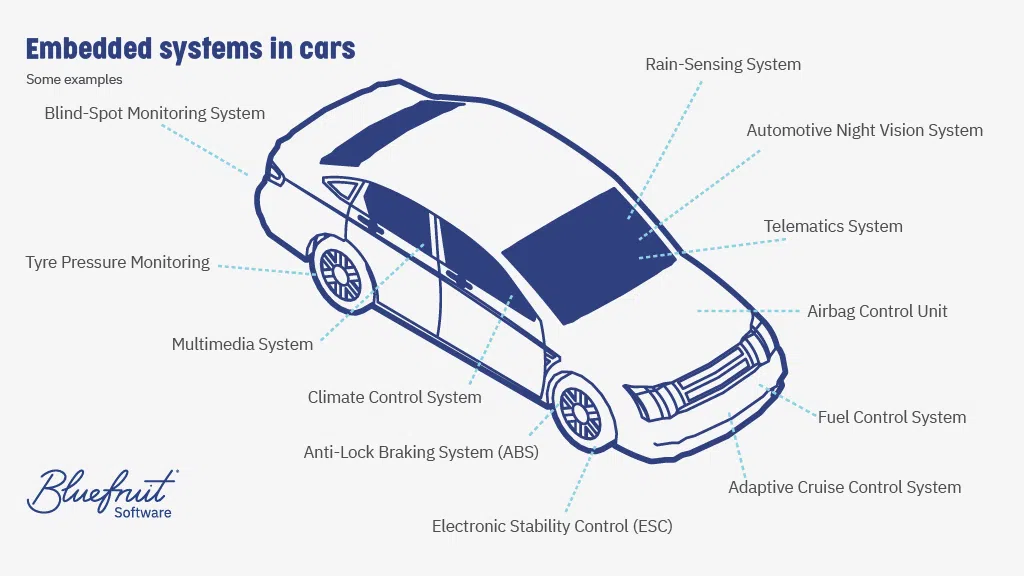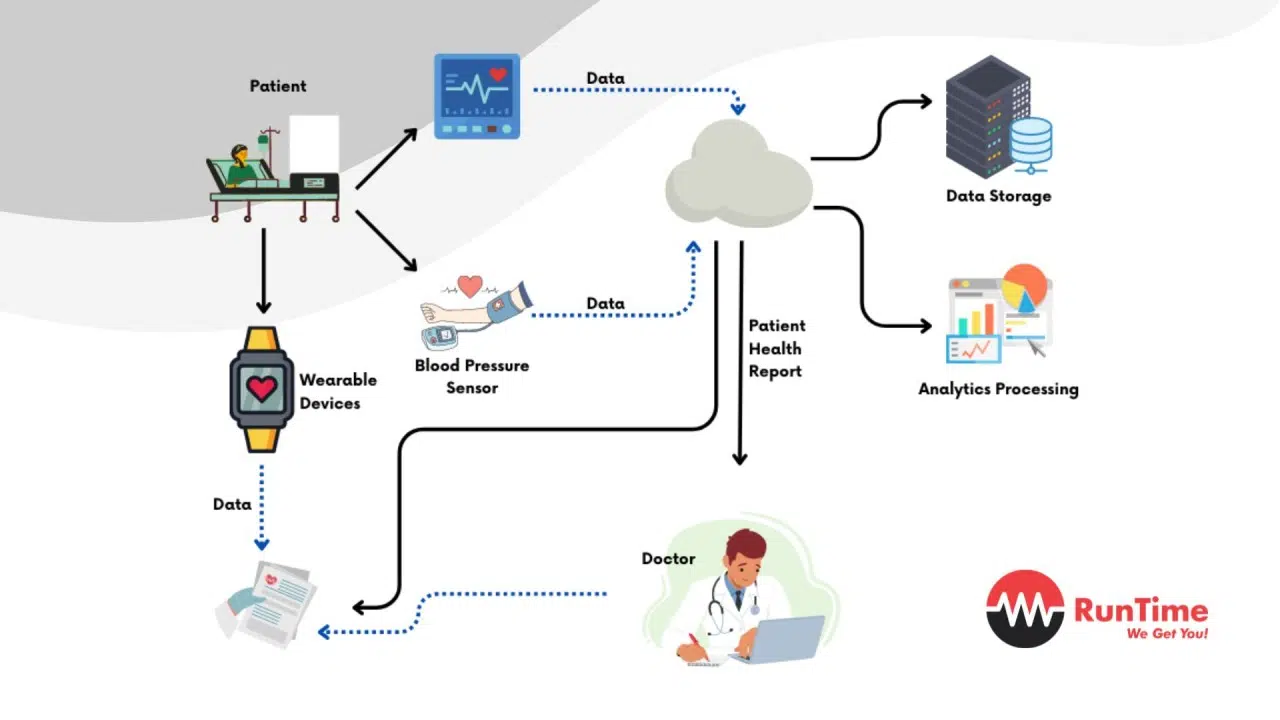What is Embedded Software Development? A Comprehensive Guide in 2025
Embedded Software Engineering revolves around managing the operations of diverse devices and machinery, distinct from conventional computers, through the application of software engineering principles. With a projected market value exceeding USD 137.5 billion by 2027, this field stands as a cornerstone of modern technological advancement.
In today’s digital landscape, where devices and systems envelop our daily lives, embedded software assumes a critical role in facilitating seamless functionality, automation, and interconnectivity. Whether it’s controlling smart appliances, managing industrial machinery, or powering automotive systems, embedded software serves as the backbone of countless innovations.
Our comprehensive guide, “What Is Embedded Software Development?” aims to equip CTOs, developers, and businesses with essential insights for navigating the complexities of selecting optimal embedded software development services or technologies for future IT endeavors.
What Is Embedded Software Development?
Basically, Embedded software development is the art of crafting software systems tailored to run on non-computer hardware. These systems are tightly integrated into the hardware, empowering it to carry out specific tasks beyond basic computing functions. Think of it as the invisible brain power behind a diverse range of devices, spanning from everyday household appliances to sophisticated industrial machinery.
Embedded software is what makes gadgets smart and responsive. It serves as the foundation of today’s electronic devices, requiring a profound grasp of hardware limitations and software complexities to ensure smooth integration and reliable performance in our ever-evolving interconnected environment.
Some Popular EmbeddedSoftware Application Cases
Most of the electronic devices and appliances we use in our daily lives contain embedded software. Here are some of the best examples:
Automotive industry
In the automotive realm, embedded software plays a pivotal role, functioning as the unseen force orchestrating various vital operations, from regulating the engine’s functions to ensuring the timely deployment of airbags in case of emergencies. It serves as the brainpower fueling sophisticated driver-assistance systems, such as the seamless automatic braking that smoothly brings a vehicle to a stop amidst congested traffic or the subtle nudges of lane-keeping assistance, guiding drivers back into their intended paths.

Embedded system in a car – Image source: Bluefruit
Consider Tesla’s Autopilot system, a prime example of the remarkable capabilities of embedded software in action. This technology empowers vehicles to autonomously navigate within designated lanes, handling steering, acceleration, and braking tasks with precision. This integration of software prowess with automotive hardware heralds a future where cars transcend mere modes of transportation, evolving into intuitive companions on our journeys.
Manufacturing industry
Embedded systems are the unsung heroes of the manufacturing world, powering automation to unprecedented levels. They serve as the intelligence behind robots that diligently put together products with utmost accuracy and act as guardians of quality assurance, guaranteeing that each item adheres to strict criteria. Constantly monitoring operations in real-time, these systems offer a continuous flow of data, optimizing efficiency.

Applying robot arms in assembling cars
A notable instance is the deployment of robotic arms in car manufacturing plants such as those found in BMW’s facilities. Here, embedded systems seamlessly integrate to boost productivity and maintain top-notch quality in every vehicle.
Smart cities
Smart cities utilize embedded software to build an interconnected urban environment that operates efficiently and responsively. By employing this technology, traffic management systems can alleviate congestion and enhance commute times.

When applied to smart city systems, embedded systems… – Image source: IoT India
Additionally, advanced surveillance and emergency services bolster public safety. Smart grids optimize energy distribution by adapting to usage patterns, while environmental monitoring systems track pollution levels and weather conditions, fostering a healthier environment. These embedded software applications collectively improve urban management and elevate the quality of life for residents, rendering future cities not only more intelligent but also more livable.
Smart homes
Smart home technology, powered by embedded systems, revolutionizes our living spaces into comfortable, convenient, and secure hubs. These systems serve as the intelligence behind various devices such as smart thermostats, security cameras, and voice-controlled assistants. They adapt to our preferences, adjusting climate settings, keeping a vigilant eye on our homes, and responding to our commands effortlessly. Together, they form a cohesive ecosystem that not only enhances our homes with intelligence but also aligns seamlessly with our lifestyles.
Healthcare

Smart healthcare system
When it comes to healthcare, embedded software plays a crucial role in advancing medical devices. It acts as the brains behind pacemakers, ensuring they regulate heartbeats seamlessly. It also powers imaging systems, enabling detailed exploration of the human body, and enhances robotic surgical instruments, extending the capabilities of surgeons. This integration of technology and medicine doesn’t just improve patient care but also enhances treatment outcomes, marking a new era of medical excellence.
Military and aerospace

Aerospace and military are always industries that need to apply a lot of technology
The military and aerospace industries rely heavily on technology to enhance their operations, with embedded systems playing a crucial role in boosting efficiency and ensuring safety. These advanced systems are essential for precise navigation, providing real-time data crucial for maneuvering through complex terrains and coordinating movements effectively. In weapons control, embedded technology enables accurate targeting and deployment of armaments, improving combat effectiveness while reducing collateral damage.
Furthermore, embedded systems form the backbone of cutting-edge communication technologies, facilitating secure and reliable data transmission vital for strategic command and control. By integrating these systems, both military and aerospace sectors enhance their situational awareness and response capabilities, which are vital in modern defense and space exploration missions.
What Is An Embedded System Software Composed Of?
Embedded systems are divided into hardware and software components, but in this article, we will only focus on the software types of embedded systems.
Looking For a Dedicated Team?
Looking to optimize your business with cutting-edge solutions in Embedded Software Development? Turn to Savvycom for unparalleled expertise and guidance! With over 15 years of experience, Savvycom offers tailored consulting services designed to meet your specific needs in Embedded Software Development. Benefit from our deep industry knowledge and proven track record as a leading IT outsourcing company in Asia to streamline your processes, drive innovation, and achieve remarkable success in embedded systems. Let us collaborate to unlock the full potential of your enterprise in the field of Embedded Software Development!
Firmware
In simple terms, firmware is like the brain of a smart device. It’s a special type of software that’s permanently stored in the device’s memory. This software is crucial because it handles important tasks like starting up the device and managing basic operations. Think of firmware as the middleman between the physical parts of your device and the software programs you interact with. It makes sure everything runs smoothly so you can enjoy using your device without any hiccups.
Device drivers
Think of device drivers as the middlemen between your computer’s operating system and its hardware parts. They’re like translators, ensuring smooth communication between your system and devices like printers, video cards, and sensors. Without these drivers, your operating system would struggle to understand and interact with hardware properly, leading to all sorts of functionality hiccups.
Real-time operating systems (RTOS)
Real-Time Operating Systems (RTOS) are essential for embedded systems requiring timely responses. Unlike regular operating systems, RTOS are specifically designed to handle tasks with precision, meeting strict timing requirements. They play a crucial role in ensuring that every task is carried out precisely when necessary, particularly in situations where any delay is unacceptable. By organizing tasks according to their urgency and significance, RTOS maintains the smooth flow of operations, allowing devices to function reliably and predictably.
Middleware
Middleware plays a crucial role in embedded systems by facilitating communication between different software components. Essentially, it acts as a bridge, connecting disparate software components and applications to ensure smooth data management across distributed environments. Although often overlooked, middleware is the unsung hero operating behind the scenes. It provides shared services and features that simplify the complexities of inter-component communication.
By handling intricate data exchanges, middleware allows developers to focus on the core functionalities of their software. This frees them from the technical intricacies, fostering an environment where innovation can flourish without being bogged down by underlying technical challenges. In essence, middleware serves as a silent facilitator of connectivity, playing a pivotal role in crafting cohesive, efficient, and robust software architectures capable of meeting evolving technological demands.
Embedded linux
Embedded Linux is a specialized version of the Linux operating system designed specifically for embedded systems. It’s known for being highly scalable and reliable, making it an ideal choice for developing software for embedded devices. Embedded Linux is valued for its flexibility, which makes it widely used across various industries. It showcases the versatility of embedded systems, with each tailored to improve device performance.
As a key component of embedded computing, Embedded Linux demonstrates the effectiveness of open-source software in fostering innovation and ensuring reliability in the embedded domain.
The Benefits Of Embedded Application Development
Enhancing procedures, automating operations, and optimizing resource utilization through embedded software systems can significantly enhance business efficiency. Let’s explore how embedded software contributes to operational effectiveness in businesses:
Monitoring and controlling in real-time
Businesses benefit greatly from embedded software systems, which play a vital role in monitoring and controlling key operations in real-time. Acting as the technological backbone, these systems empower businesses to react promptly to any changes in their environment or within their operations. This ability to access real-time insights enables swift decision-making, thereby minimizing the risk of costly downtimes and ensuring consistent performance. Such systems are particularly invaluable in industries where conditions evolve rapidly, and delays can incur significant expenses.
By harnessing the advanced monitoring capabilities offered by embedded software systems, businesses can maintain a competitive advantage by promptly adjusting to market demands and operational hurdles. The incorporation of real-time control systems results in heightened efficiency, improved resource utilization, and ultimately, a more robust financial performance.
Analysis and interpretation of data
Embedded software systems are crucial in contemporary business operations, acting as the cornerstone for analyzing and deciphering data. They collect information from diverse sensors and devices, processing it to yield valuable insights. Delving into this data allows organizations to make educated choices, driving improvements across various facets of their activities. This analytical prowess is particularly critical for identifying patterns, predicting results, and crafting strategies aligned with business objectives. As a result, businesses can optimize operations, enhance customer contentment, and foster innovation.
Automating processes
Integrating embedded software into automated processes represents a big step forward in making operations smoother and more efficient. This technology takes care of repetitive tasks, cutting down on the need for constant human supervision and making workflows more seamless. Automated systems are super precise, which means fewer mistakes and better-quality results overall. This boosts productivity for businesses since employees can focus on the stuff that really needs human brains.
Plus, using less manual labor saves money and speeds things up, helping companies stay on top of what customers want. So, basically, embedding software in process automation isn’t just about making things a bit better—it’s about completely changing the game, pushing industries towards a future where getting things done right and fast is the name of the game.
Incorporating with current business systems
Seamlessly integrating embedded software into existing systems is more than just a strategic move – it’s essential for success. This smooth blending ensures that new technologies work hand-in-hand with Customer Relationship Management (CRM) and Enterprise Resource Planning (ERP) systems, rather than causing disruptions. By achieving this synergy, businesses create a cohesive environment where data flows freely and different departments collaborate seamlessly.
Then, a well-coordinated operation where real-time data from embedded systems guides decision-making at every level. This integration doesn’t just streamline processes; it also lays a solid groundwork for future technological advancements. It’s a pivotal step that allows businesses to adapt, embrace new capabilities, and foster innovation without interrupting established workflows.
Managing and connecting remotely
Embedded software systems have transformed how businesses oversee and link their operations from afar. With these systems, you can oversee and control devices from nearly any location, offering a newfound flexibility and command that was once out of reach. This remote accessibility proves especially advantageous for tasks like upgrades, issue-solving, and upkeep, guaranteeing that systems uphold their efficiency and functionality, no matter where technical staff are physically situated.
Being able to connect and manage systems remotely not only saves time but also diminishes the necessity for on-site visits, which can incur significant costs and consume valuable time.
Anticipating maintenance needs
Businesses can stay ahead of device issues and plan maintenance in advance through embedded software equipped with predictive maintenance algorithms. This software marks a significant shift in how equipment health is managed. By tapping into data analytics, companies not only foresee potential device problems but also take preemptive measures to address them. This proactive approach enables them to schedule maintenance well in advance, sidestepping the disruptions caused by unexpected downtime. Employing predictive algorithms strategically ensures that assets consistently perform at their best, maximizing their efficiency.
Key Steps To Building An Embedded Software Effectively
Creating custom embedded software involves a detailed process that demands careful attention to both hardware and software elements. Here’s a simplified guide to the step-by-step process:
- Clarify System Requirements: First things first, you need to clearly outline what the system should do, how fast it should do it, and any limits it might face. This sets the stage for everything else and makes sure everyone’s on the same page.
- Pick the Right Tools: Next, you’ll want to choose the best hardware and software for the job. Think about things like how fast the hardware can process information, how much memory it has, and if it’ll play nice with the software you’re using to build your project.
- Design in Bits and Pieces: When you’re building the software, think modular. This means breaking it down into smaller, easier-to-handle chunks. Doing this makes it simpler to fix problems, grow your project, and work on different parts at the same time.
- Test, Test, Test: Throughout the whole development process, make sure to test your software thoroughly. Try out different parts to catch any bugs early on. You can test each piece on its own, see how they work together, and then check the whole system to make sure everything runs smoothly.Follow the Rules: Stick to the rules and guidelines set by the industry for embedded software. This makes sure your product is safe, works well with other devices, and meets any legal requirements.
- Think Ahead: Finally, plan for the future. Your software might need to grow or change over time, so build it in a way that makes updates easy. You can include features like automatic updates and make sure your design can adapt to new technologies down the line.
Criteria In Choosing Embedded Software Development Company
Choosing the right embedded software development company plays a vital role in the outcome of your project. To simplify your decision-making process, consider the following factors:
- Relevant Expertise: Seek a company well-versed in the technologies and industries pertinent to your project.
- Proven Success: Review their past projects to gauge their ability to deliver satisfactory results.
- Emphasis on Quality and Security: Prioritize companies with stringent quality standards and robust security measures.
- Adherence to Deadlines and Budgets: Look for a track record of punctuality and financial accountability.
- Effective Communication and Project Management: Ensure transparent communication channels and proficient project managers are in place.
By assessing these criteria, you can align your technical needs with your business objectives, fostering a fruitful collaboration for your project’s success.
In Conclusion
Embedded software development combines software engineering with electronic device design to craft specialized computing systems. This field is gaining importance as technology advances, playing a pivotal role in spurring innovation across diverse industries. As a result, it stands out as a significant domain for future technological progress.
Savvycom – Your Trusted Tech Partner!
Step into the future of manufacturing with groundbreaking embedded solutions from Savvycom, the pinnacle of IT outsourcing in Asia, pioneering digital transformation since 2009. Harnessing our profound expertise, we specialize in crafting bespoke IoT solutions tailored precisely to your requirements. From optimizing production lines to boosting equipment efficiency and enabling real-time data analytics, we offer comprehensive solutions to propel manufacturing into a new era. Partner with us to unlock the potential of IoT technology and drive innovation across your industry.
Join the manufacturing revolution today! Collaborate with Savvycom, the foremost software development company in Asia, and revolutionize your industry with state-of-the-art IoT solutions. Let’s ignite innovation together!
Savvycom is right where you need. Contact us now for further consultation:
- Phone: +84 24 3202 9222
- Hotline: +84 352 287 866 (VN)
- Email: [email protected]
Frequently Asked Questions
What is the job of an embedded programming engineer?
Embedded programming engineers are the maestros of technology, conducting the intricate symphony of software that animates embedded systems. Their expertise lies in crafting, refining, testing, and upkeeping software that seamlessly integrates with hardware.
Working hand in hand with hardware engineers, they customize software to fit unique hardware setups, guaranteeing optimal functionality and steadfast dependability. These engineers are the masterminds behind the unseen yet crucial software driving everyday devices, spanning from basic gadgets to intricate machinery.
What steps are required to develop an embedded system?
- Ideation: Generate and refine ideas for the embedded system’s functionality and purpose.
- Detailed Technical Specification: Create a comprehensive document outlining the technical requirements and specifications of the system.
- Architecting the Solution: Design the overall architecture of the embedded system, including hardware and software components.
- Component Selection & Design: Choose appropriate hardware components and develop software components to meet the system’s requirements.
How can we improve embedded systems?
- Hardware Selection: Choose suitable hardware components to enhance system responsiveness and efficiency.
- Software Optimization: Optimize software algorithms and code to improve system performance and responsiveness


